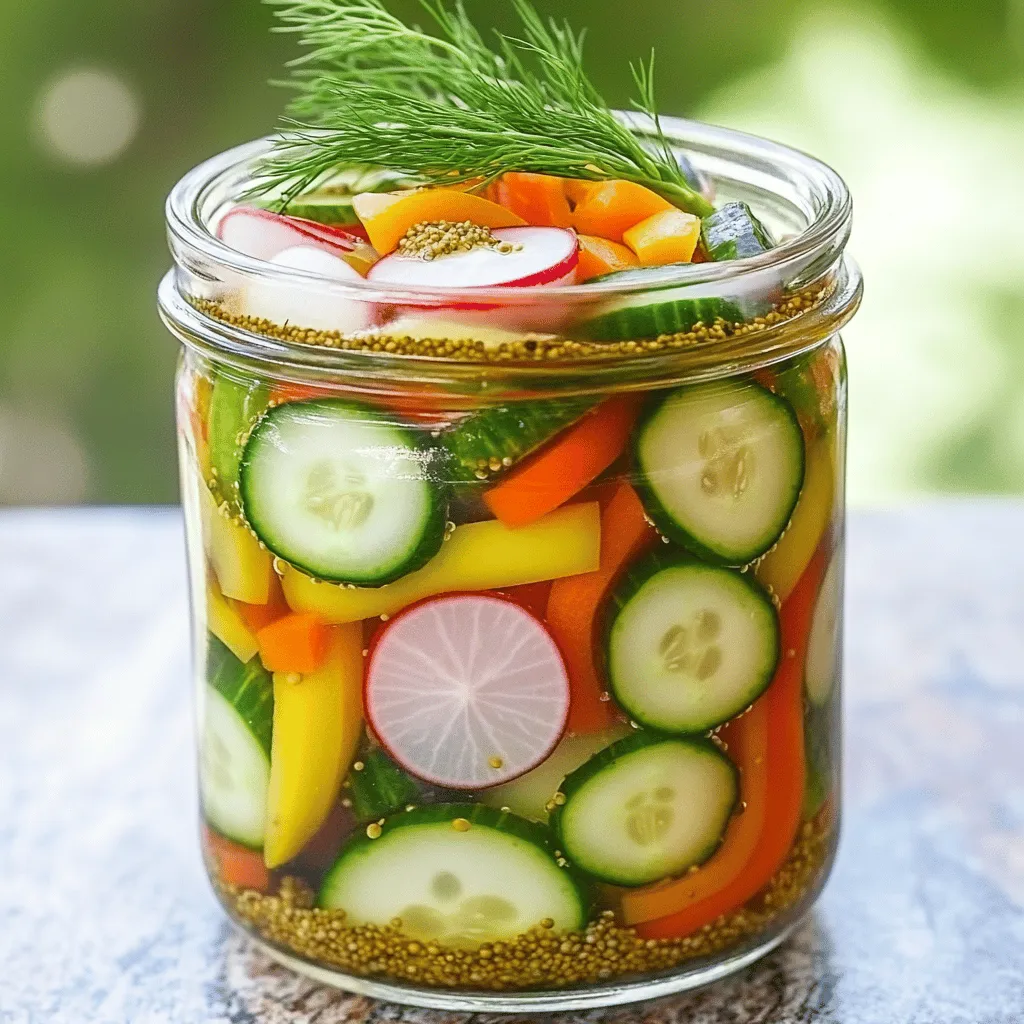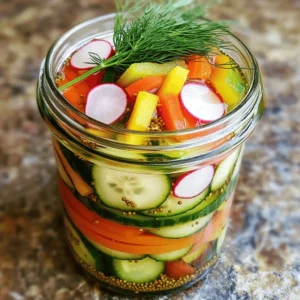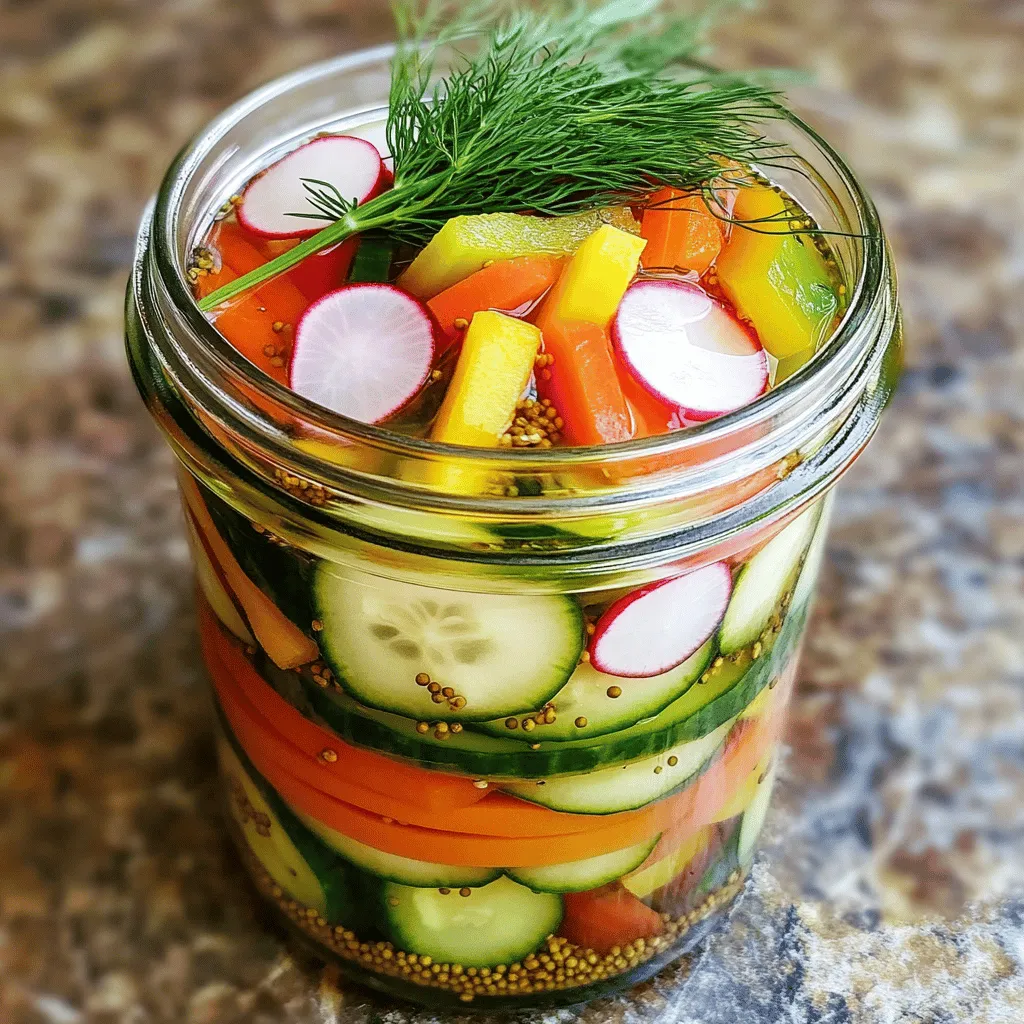Are you ready to add crisp, tangy flavor to your meals? Quick pickled vegetables are a fast and fun way to elevate your dishes. In this easy recipe, I’ll guide you through essential ingredients, simple steps, and handy tips. You’ll learn how to create delicious pickles at home, without fuss. Let’s dive into the tasty world of quick pickling and make your next meal a whole lot better!
Ingredients
Essential Vegetables for Pickling
You can use many vegetables for quick pickles. Here are my favorites:
– 1 cup thinly sliced cucumbers
– 1 cup thinly sliced radishes
– 1 cup julienned carrots
– 1 cup thinly sliced bell peppers (mix of colors)
These veggies add bright colors and crunch. They also soak up flavors well.
Pickling Liquid Components
The pickling liquid is key for taste. This mix gives your pickles a zing. You’ll need:
– 1 cup white vinegar
– 1 cup water
– 2 tablespoons sugar
– 1 tablespoon salt
The vinegar adds tartness. Sugar balances it out. Salt helps preserve and enhance flavors.
Optional Flavor Enhancements
You can make your pickles unique with other spices. Here’s what I like to add:
– 1 teaspoon mustard seeds
– 1 teaspoon coriander seeds
– 1 teaspoon crushed red pepper flakes (adjust for spice preference)
– Fresh dill sprigs for garnish
These spices add depth. They give your pickles a special twist. Feel free to experiment with your favorites! For the complete recipe, check out the Full Recipe section.
Step-by-Step Instructions
Prepping the Vegetables
First, gather your veggies. You will need cucumbers, radishes, carrots, and bell peppers. Wash them well. Thinly slice each cucumber and radish. Julienning the carrots gives nice texture. Slice the bell peppers, mixing colors for a fun look. Place all the sliced veggies in a large mixing bowl. Toss them gently to ensure they mix evenly.
Creating the Pickling Brine
Now, let’s make the brine. In a saucepan, combine one cup of white vinegar, one cup of water, two tablespoons of sugar, and one tablespoon of salt. Add one teaspoon of mustard seeds and one teaspoon of coriander seeds for flavor. If you like heat, include one teaspoon of crushed red pepper flakes. Heat this mixture over medium heat. Stir until it simmers and the sugar dissolves.
Combining and Storing
Once your brine is ready, pour it over the veggies in the bowl. Ensure all the vegetables are submerged. Let the mixture cool at room temperature for about 20-30 minutes. After that, transfer everything to a sterilized jar or airtight container. Seal it tightly and place it in the fridge. For the best taste, let the veggies pickle overnight. You can serve them chilled, garnished with fresh dill sprigs. Enjoy your zesty rainbow quick pickles! Check the Full Recipe for more details.
Tips & Tricks
Best Practices for Quick Pickling
To make the best quick pickles, always use fresh vegetables. Fresh veggies taste better and crunchier. Slice them evenly for uniform pickling. Thin slices allow the flavors to soak in quickly. Try to use a mix of colors for a vibrant look. This makes them fun to eat and pretty on the plate. Keep your jars clean and sterilized to avoid spoilage.
Enhancing Flavor Profiles
Adding spices boosts the flavor of your pickles. Mustard seeds and coriander seeds add a warm taste. For extra heat, use crushed red pepper flakes, adjusting to your liking. Fresh dill sprigs give a nice herbal touch. You can also try garlic cloves for a punchy flavor. Experiment with different herbs to find your favorite mix. Using a bit of sugar balances the vinegar’s tartness.
Common Mistakes to Avoid
One common mistake is skimping on the pickling liquid. Make sure your veggies are fully submerged. If not, they will not pickle evenly. Don’t rush the cooling process. Allow the brine to cool before pouring it over the vegetables. This helps preserve the crunch. Avoid using old or wilted vegetables. They won’t give you the best taste or texture. Always taste your brine before adding it to the veggies. Adjust the seasoning if needed.

Variations
Different Vegetable Combinations
You can mix and match many vegetables for quick pickles. Try using:
– Cauliflower florets
– Thinly sliced red onions
– Shredded cabbage
– Baby carrots
These choices work well with the zesty brine. Each veggie adds its own taste and crunch. You can even use leftover vegetables from your fridge. Be creative!
Unique Flavor Additions
To make your quick pickles stand out, add unique flavors. Here are some ideas:
– Fresh garlic cloves
– Ginger slices
– Bay leaves
– Lemon zest
These additions change the taste and make the pickles special. Experiment with flavors that you enjoy.
Seasonal Picks for Quick Pickling
Seasonal vegetables can enhance your pickling experience. In spring, use:
– Asparagus
– Radishes
In summer, try:
– Green beans
– Zucchini
In fall, pick:
– Beets
– Brussels sprouts
Using seasonal vegetables not only tastes great but also supports local farms. For the full recipe, make sure to check out the zesty rainbow quick pickles.
Storage Info
How to Properly Store Quick Pickled Vegetables
Store your quick pickled vegetables in a clean, airtight jar. Glass jars work best. Make sure the vegetables stay submerged in the brine. This keeps them fresh and tasty. Always use a lid that seals well to avoid air exposure.
Shelf Life and Best Practices
Quick pickles can last about 1 to 2 weeks in the fridge. For the best taste, eat them within a week. Keep the jar in the fridge right after pickling. Do not leave them out at room temperature. This helps prevent spoilage. If you want to keep them longer, think about canning. Canning may extend their shelf life up to a year.
Signs of Spoilage
Check for signs of spoilage. If the color changes or the pickles smell bad, toss them out. Look for mold or off textures. If you see bubbles in the jar that weren’t there before, that’s a red flag too. Always trust your senses to keep your food safe.
FAQs
How long do quick pickled vegetables last?
Quick pickled vegetables can last for about 2 to 4 weeks in the fridge. The vinegar helps preserve them. Always check for any signs of spoilage, like off smells or changes in color. Store them in a clean, tight jar to keep them fresh.
Can I use other vegetables for pickling?
Yes, you can use many vegetables for pickling. Some favorites include cauliflower, green beans, and red onions. Just remember to slice them thinly for the best results. Mixing different veggies adds fun colors and flavors to your pickles.
What are the health benefits of pickled vegetables?
Pickled vegetables are tasty and nutritious. They often contain probiotics, which are good for gut health. Pickles can add vitamins and minerals to your meals. They also make great low-calorie snacks, helping you stay full longer.
Do I need to heat the pickling liquid?
Yes, heating the pickling liquid helps dissolve the sugar and salt. This step also ensures the veggies absorb the flavors better. Just bring the mixture to a simmer, then pour it over your veggies.
Can I reuse pickling brine?
You can reuse pickling brine for a second batch. Just remember to add fresh vegetables. However, the flavor may decrease after the first use. If the brine looks cloudy or smells off, it’s best to make a new batch.
For the full recipe, check out the Zesty Rainbow Quick Pickles.
In this post, we explored how to quick pickle vegetables. We covered essential ingredients, step-by-step instructions, and helpful tips. You now know how to prep vegetables, create a tasty brine, and store pickles safely.
Pickling lets you enjoy fresh flavors all year. Experiment with different veggies and spices. With practice, your pickling skills will shine. Enjoy your crunchy, tangy creations!

